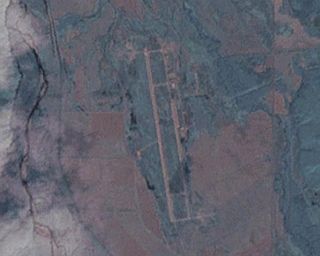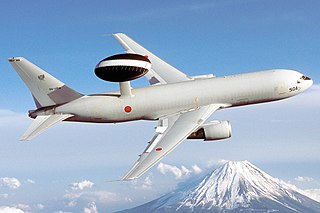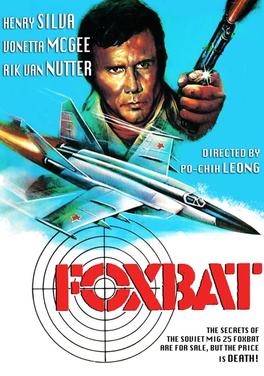
The Mikoyan-Gurevich MiG-21 is a supersonic jet fighter and interceptor aircraft, designed by the Mikoyan-Gurevich Design Bureau in the Soviet Union. Its nicknames include: "Balalaika", because its planform resembles the stringed musical instrument of the same name; "Ołówek", Polish for "pencil", due to the shape of its fuselage, and "Én Bạc", meaning "silver swallow", in Vietnamese.

The Mikoyan-Gurevich MiG-15 is a jet fighter aircraft developed by Mikoyan-Gurevich for the Soviet Union. The MiG-15 was one of the first successful jet fighters to incorporate swept wings to achieve high transonic speeds. In aerial combat during the Korean War, it outclassed straight-winged jet day fighters, which were largely relegated to ground-attack roles. In response to the MiG-15's appearance and in order to counter it, the United States Air Force rushed the North American F-86 Sabre to Korea.

The Mikoyan MiG-29 is a twin-engine fighter aircraft designed in the Soviet Union. Developed by the Mikoyan design bureau as an air superiority fighter during the 1970s, the MiG-29, along with the larger Sukhoi Su-27, was developed to counter new U.S. fighters such as the McDonnell Douglas F-15 Eagle and the General Dynamics F-16 Fighting Falcon. The MiG-29 entered service with the Soviet Air Forces in 1983.

The Mikoyan-Gurevich MiG-23 is a variable-geometry fighter aircraft, designed by the Mikoyan-Gurevich design bureau in the Soviet Union. It is a third-generation jet fighter, alongside similar Soviet aircraft such as the Su-17 "Fitter". It was the first Soviet fighter to field a look-down/shoot-down radar, the RP-23 Sapfir, and one of the first to be armed with beyond-visual-range missiles. Production started in 1969 and reached large numbers with over 5,000 aircraft built, making it the most produced variable-sweep wing aircraft in history. The MiG-23 remains in limited service with some export customers.

The Mikoyan-Gurevich MiG-25 is a supersonic interceptor and reconnaissance aircraft that is among the fastest military aircraft to enter service. Designed by the Soviet Union's Mikoyan-Gurevich bureau, it is an aircraft built primarily using stainless steel. It was to be the last plane designed by Mikhail Gurevich, before his retirement.

The Mikoyan MiG-31 is a supersonic interceptor aircraft developed for the Soviet Air Forces by the Mikoyan design bureau as a replacement for the earlier MiG-25 "Foxbat"; the MiG-31 is based on and shares design elements with the MiG-25.

The Syrian Air Force, officially the Syrian Arab Air Force, is the air force branch of the Syrian Armed Forces. It was established in 1948. Land-based air defense systems are grouped under the Syrian Arab Air Defense Force, which split from both the Air Force and the Army.

Viktor Ivanovich Belenko was a Russian-born American aerospace engineer and Soviet pilot who defected in 1976 to the West while flying his MiG-25 "Foxbat" jet interceptor and landed in Hakodate, Japan. George H. W. Bush, the Director of Central Intelligence at the time, called the opportunity to examine the plane up close an "intelligence bonanza" for the West. Belenko later became a U.S. aerospace engineer.

Hakodate Airport is an airport located 7.6 km (4.7 mi) east of Hakodate Station in Hakodate, a city in Hokkaidō, Japan. It is owned by the Ministry of Land, Infrastructure, Transport and Tourism and operated by Hokkaido Airports.

The BisnovatR-40 is a long-range air-to-air missile developed in the 1960s by the Soviet Union specifically for the MiG-25P interceptor, but can also be carried by the later MiG-31. It is the largest air-to-air missile in the world ever to go into production.

Captain Munir Redfa, born Munir Habib Jamil Rufa was an Iraqi fighter pilot. After Qasim's coup, Redfa was one of only five pilots the new regime trusted to continue serving with the sole Iraqi unit operating the Mikoyan-Gurevich MiG-21, 11th Squadron.

The Korean People's Army Air Force is the unified military aviation force of North Korea. It is the second largest branch of the Korean People's Army comprising an estimated 110,000 members. As of 2024, it is estimated to possess some 570 combat aircraft, 200 helicopters, and a few transporters, mostly of decades-old Soviet and Chinese origin. Its primary task is to defend North Korean airspace. In April 2022, the Korean People's Army Air and Anti-Air Force name was changed to Korean People's Army Air Force.

The Libyan Air Force is the branch of the Libyan Armed Forces responsible for aerial warfare. In 2010, before the Libyan Civil War, the Libyan Air Force personnel strength was estimated at 18,000, with an inventory of 374 combat-capable aircraft operating from 13 military airbases in Libya. Since the 2011 civil war and the ongoing conflict, multiple factions fighting in Libya are in possession of military aircraft. As of 2019 the Libyan Air Force is nominally under the control of the internationally recognised Government of National Accord in Tripoli, though the rival Libyan National Army of Marshal Khalifa Haftar also has a significant air force. In 2021, the air force is under command of the new President of Libya, Mohamed al-Menfi that replaced Fayez al-Sarraj.

Chuguyevka is a military air base of the Russian Air Force in Primorsky Krai, Russia. It is located in Chuguyevsky District, near the towns of Chuguyevka and Bulyga-Fadeyevo, 190 kilometers (120 mi) north-east of Vladivostok. The base was also written in various references as Chuguevka, Sandagou, Sikharovka (erroneous), Sakharovka (erroneous), Sokolovka, and Bulyga-Fadeyevo.

The Boeing E-767 is an Airborne Warning and Control System (AWACS) aircraft that was designed in response to the Japan Air Self-Defense Force's requirements. It is essentially the Boeing E-3 Sentry's surveillance radar and air control system installed on a Boeing 767-200.

Operation Diamond was an operation undertaken by Mossad. Its goal was the acquisition of a Soviet-built Mikoyan-Gurevich MiG-21, the most advanced Soviet fighter plane at that time. The operation began in mid-1963 and ended on August 16, 1966, when an Iraqi Air Force MiG-21, flown by the Iraqi Assyrian defector Munir Redfa, landed at an air base in Israel. Israel and the United States were able to study the design of the plane.

Foxbat is a 1977 action spy film directed by Po-Chih Leong, co-written by Terence Young, and starring Henry Silva, Vonetta McGee, Rik Van Nutter, and Roy Chiao. It is based on an original story by Philip Chan and Leong, and is based on the circumstances surrounding the defection of Soviet Air Force pilot Viktor Belenko and the capture of the MiG-25 “Foxbat” fighter.
The 1987 Okinawan Tu-16 airspace violation was an incident on December 9, 1987 in which a Tupolev Tu-16P Badger J1 of the Soviet Air Force repeatedly entered Japanese airspace over Okinawa and Kagoshima prefectures. This prompted a F-4EJ Phantom fighter of the Japan Air Self-Defense Force (JASDF) to fire warning shots on two occasions. It was the first time aircraft of the JASDF had done so in response to an aircraft intruding in Japanese airspace. The Soviet Union apologized, claiming that the intrusion was accidental and due to meteorological conditions.

On September 6, 1976, Lieutenant Viktor Belenko of the Soviet Air Defense Forces defected by flying his Mikoyan-Gurevich MiG-25P "Foxbat" aircraft from near Vladivostok in the Far East of the Soviet Union to Hakodate Airport in Hokkaido Prefecture of Japan.


















